Ever wondered how to turn a tiny space into a stunning, functional haven? Small rooms are incredibly popular because they challenge us to think creatively about design, proving that less can truly be more. Whether it’s a cozy apartment nook, a compact home office, or a charming guest room, clever small room inspo can help you maximize every inch while adding style and personality.
In this article, you’ll find a treasure trove of inspiring ideas and practical tips to transform any confined space into a vibrant, organized retreat. From smart furniture solutions and space-saving hacks to eye-catching color schemes and decorative touches, we’ve got you covered. Get ready to discover fresh concepts that will boost your creativity and make your small space feel bigger, brighter, and beautifully yours!
1. Clever Multi-Functional Furniture Solutions for Small Rooms
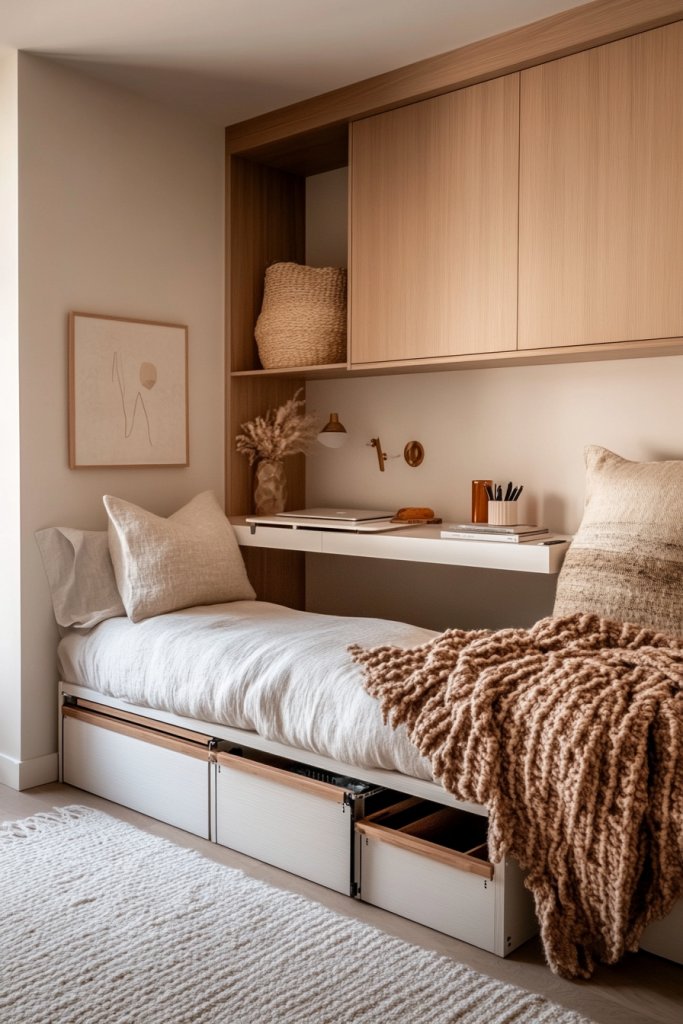
Maximizing functionality in a small space is essential, and multi-functional furniture is a game-changer. These pieces help you do more with less, transforming a cramped room into a versatile sanctuary without sacrificing style.
Whether it’s a sofa bed, an ottoman with hidden storage, or a fold-away desk, clever furniture solutions make every square inch count. Imagine a sleek sofa bed in a cozy living nook, upholstered in soft neutral fabric like dove gray, which easily shifts from seating to sleeping surface.
A benchtable doubles as a coffee table and storage for blankets or books, topped with a textured woven cushion for added comfort. Wall-mounted fold-out desks in a crisp white finish tuck neatly against the wall, revealing a workspace only when needed, and disappearing when not in use.
These pieces are often crafted from light wood or composite materials, enhancing the airy feel of the room. The textures—smooth surfaces paired with plush cushions—invite both practicality and comfort.
To recreate this look, start with a convertible sofa bed or storage ottoman as your centerpiece. Incorporate wall-mounted desks or folding tables made from bamboo or laminate for a budget-friendly option.
Use soft textiles like a chunky knit throw blanket or velvet cushions for tactile warmth. Keep the space organized with hidden storage compartments and choose light, neutral hues to maintain the room’s openness. This approach ensures your small space is both functional and inviting.
2. Vertical Storage Hacks to Maximize Space and Declutter
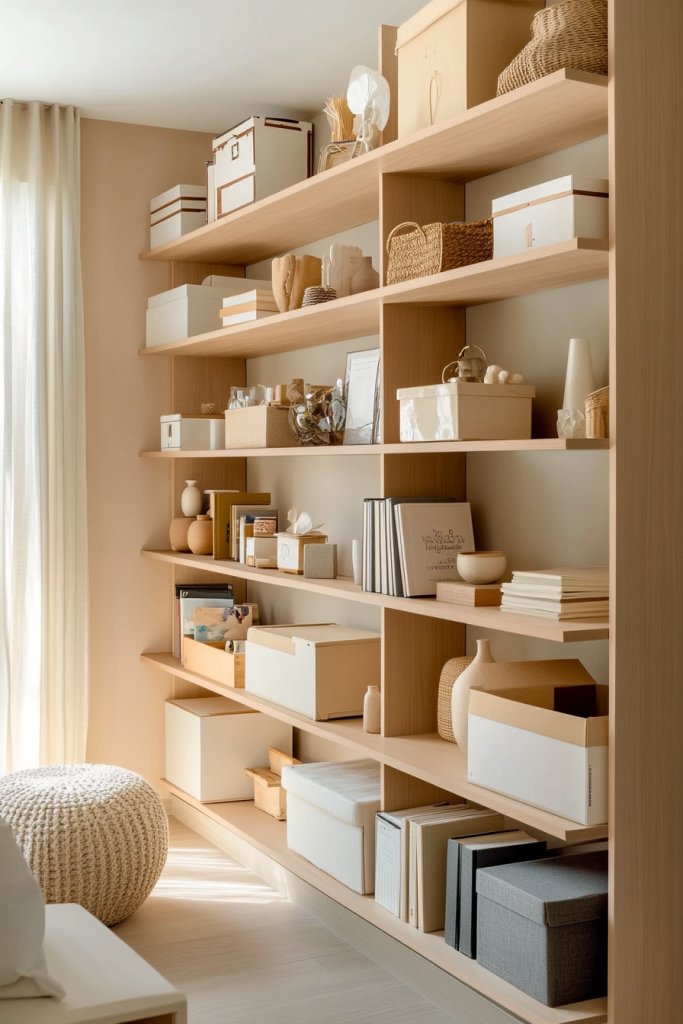
Harnessing vertical space is one of the smartest ways to keep a small room organized and feeling spacious. By extending storage upward, you free up precious floor area while adding visual interest.
Floating shelves, tall cabinets, and wall-mounted units are all excellent tools to achieve this goal. Picture a wall lined with white or natural wood floating shelves holding books, ceramics, and decorative objects.
These shelves are spaced at varying heights, creating a dynamic, layered look that draws the eye upward. Adjacent to this, a tall, slim storage cabinet in matte black or soft pastel provides ample room for clothes, accessories, or essentials, with doors that hide clutter away.
Use over-the-door hooks or wall-mounted racks for smaller items like bags, hats, or jewelry. These solutions not only save space but also add a modern, curated feel to the room.
The textures of wood, matte finishes, and woven baskets contribute to a cozy yet organized aesthetic. To implement, start by installing sturdy floating shelves made from reclaimed wood or laminate in a neutral tone.
Pair with a tall storage unit for larger items, choosing a style that complements your room’s color palette. Use storage baskets in natural fibers or soft textiles for smaller items.
Make sure to secure heavy shelves properly to avoid accidents. This vertical approach transforms clutter into a stylish display, making your small space feel more open and orderly.
3. Bright Color Palettes to Make Small Rooms Feel Larger and Airy
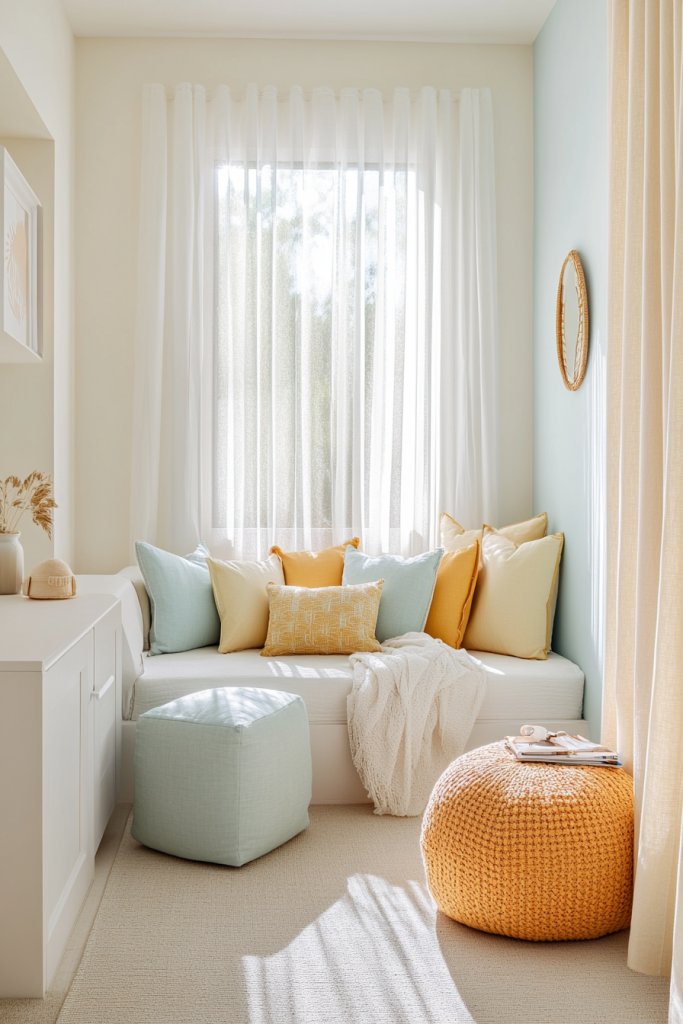
Color choice plays a pivotal role in the perception of space. Bright, light hues can open up a room, making it feel larger, more inviting, and full of energy.
Strategic use of color palettes can turn even the tiniest room into a fresh, airy retreat. Envision a small room painted in a soft cream or pale blush, with accents of white, light gray, and touches of pastel blue.
These colors reflect natural light, bouncing around the space and creating a sense of openness. Complement this with textured textiles like a plush white shag rug, linen curtains, and cushions in coordinating shades.
The walls are kept simple, allowing the colors and textures to stand out without overwhelming. Natural light filtering through sheer curtains enhances the brightness, while subtle metallic or glass accents add a hint of sophistication.
The overall effect is a space that feels larger, calmer, and more welcoming. To achieve this palette, start with a light-colored wall paint—think oyster white or pale mint—and incorporate matching textiles and decor.
Use reflective surfaces like mirrors or glass decor to amplify light. Keep furniture in white or light wood tones to maintain the airy vibe.
Introducing small pops of pastel or metallic accents adds visual interest without cluttering the space. This approach makes your small room feel expansive, fresh, and truly inspiring.
4. Using Mirrors to Create the Illusion of Depth and Space
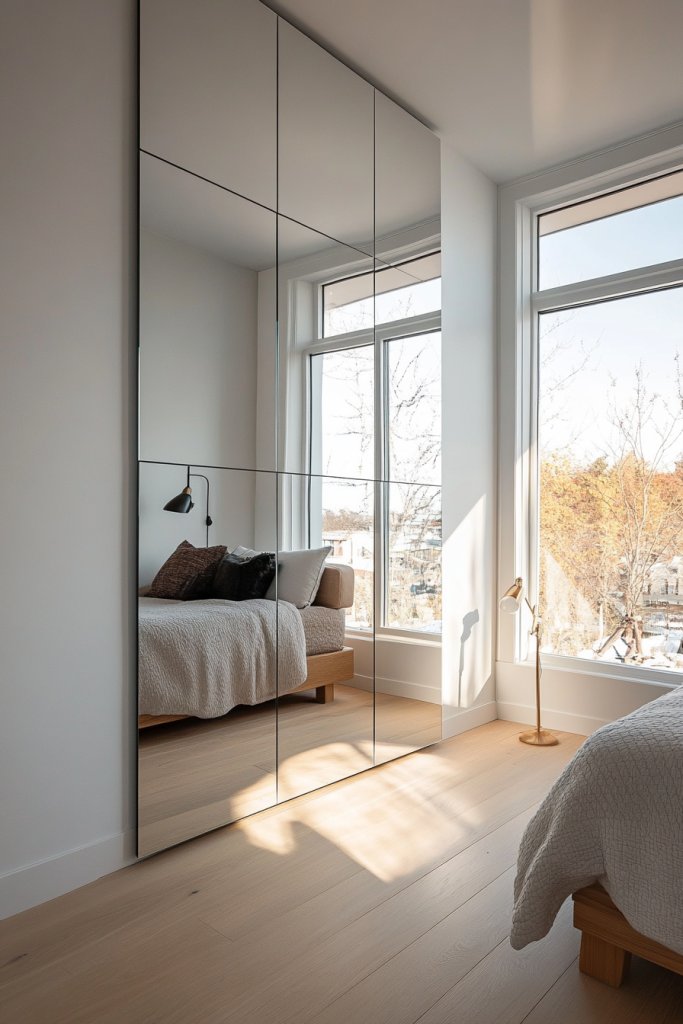
Mirrors are a small-room designer’s best friend, instantly doubling visual space and adding depth. When placed thoughtfully, mirrors reflect light and create an illusion of openness that transforms a cramped room into something much larger and brighter.
Imagine a large floor-length mirror leaning against a wall, with a sleek, minimal frame in brushed gold or matte black. Position it opposite a window to reflect natural light, amplifying brightness and making the space feel airy.
Alternatively, a set of smaller, decorative mirrors arranged in a geometric pattern can serve as a statement piece and visually expand the wall. The reflective surfaces bounce light around the room, highlighting the textures of a linen throw or wicker baskets, and visually elongate the space.
The mirror’s frame can complement your decor style, from modern metallics to vintage wood, adding aesthetic appeal. To incorporate, hang a large mirror on a focal wall or lean one against it for an easy, damage-free option.
Use mirror decals or mirrored closet doors if permanent installation isn’t feasible. Position the mirror where it captures the most natural light, and pair it with light-colored walls and decor. This simple addition can dramatically enhance your small room’s sense of openness and make it feel more expansive and inviting.
5. Compact Wall-Mounted Desks for Work or Study Areas
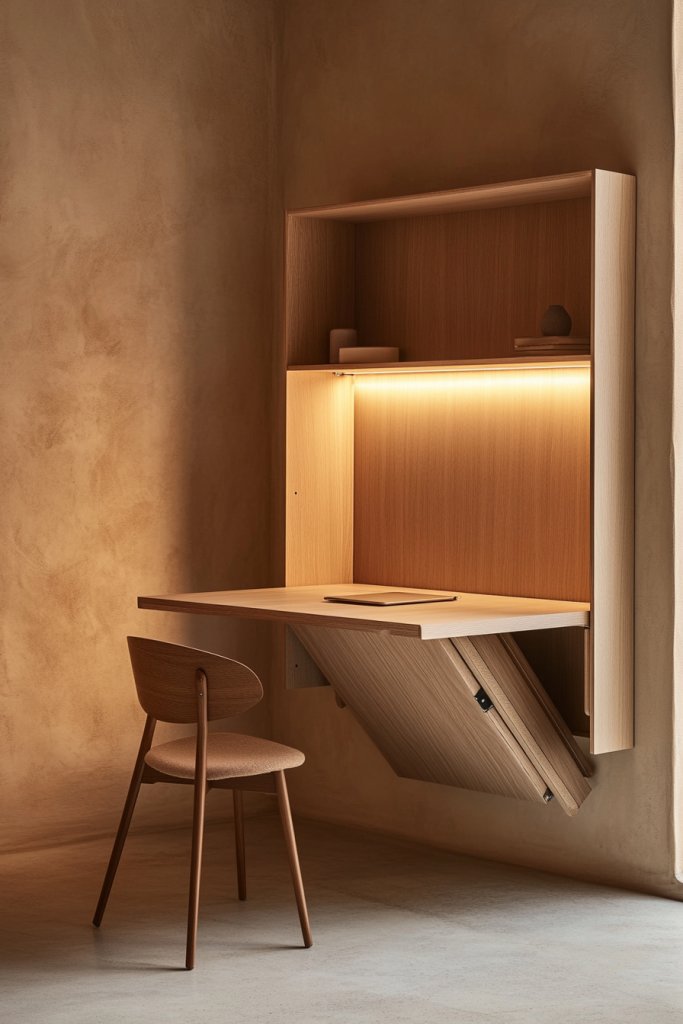
Creating a dedicated workspace in a tiny room can be challenging, but a wall-mounted desk offers a sleek, space-saving solution perfect for a home office, study nook, or craft corner. When folded up, it disappears, leaving the room open and uncluttered.
Visualize a white or natural wood fold-down desk attached to the wall, with a simple metal bracket that supports a sturdy surface. When in use, it opens to reveal a compact workspace, complete with a small desk lamp, a notepad, and a few essential supplies.
When not needed, simply fold it up to reveal a clean wall surface, perhaps decorated with a gallery wall of photos or prints. The desk’s surface can be made from bamboo, laminate, or reclaimed wood, depending on your budget and style.
Pair it with a small, comfortable stool or floating shelf for additional storage or organization. The overall look is minimal, functional, and visually light.
To set up, install the wall-mounted desk brackets securely into studs or wall anchors, and choose a durable surface material. Keep clutter minimal by adding small wall organizers or magnetic strips for tools and supplies. This clever solution provides a dedicated workspace without sacrificing precious floor space, making your small room more functional and stylish.
6. Creative Niche and Recessed Shelving for Display and Storage
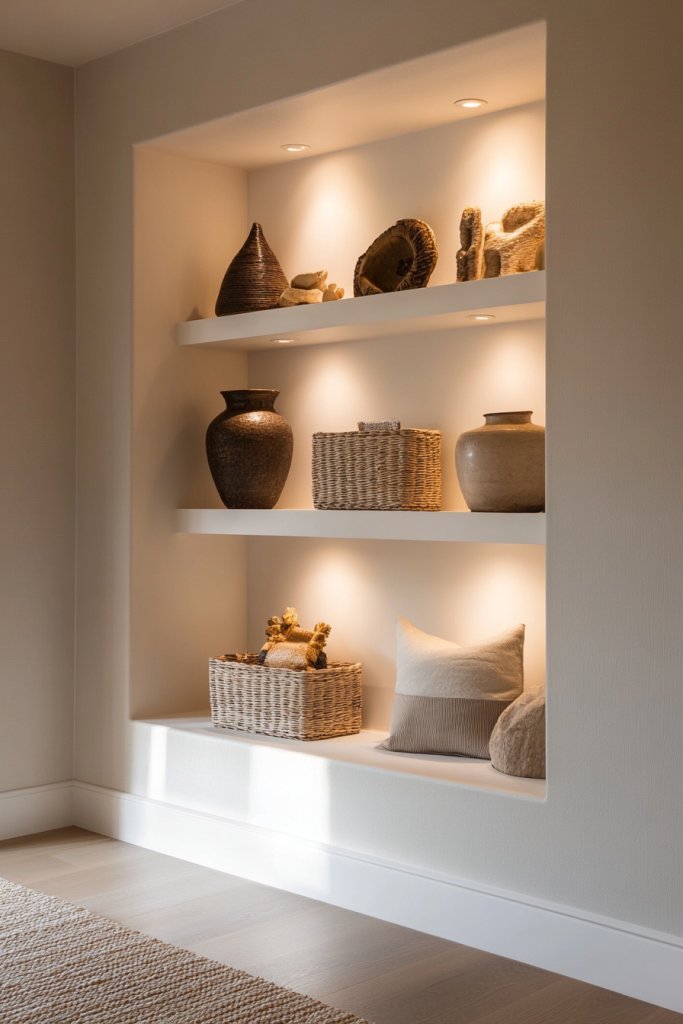
Integrating niches and recessed shelves into your small room is a smart way to add storage and a touch of personality without encroaching on floor space. These built-in features utilize existing wall space, turning awkward corners or unused sections into attractive display zones or hidden compartments that keep clutter out of sight while showcasing your favorite decorative pieces.
Visualize a narrow, recessed wall niche painted in a soft, matte blush or muted sage green. Inside, you’ve arranged a few small ceramic vases, a stack of curated books, and a tiny sculpture, all illuminated by a warm LED strip light that highlights their textures and colors.
The surrounding wall remains clean and uncluttered, drawing your eye to this curated display. These shelves can be painted to match or contrast with the wall, adding depth and visual interest to the room.
Getting started is straightforward: identify a wall or corner suitable for a recessed shelf—ideally, a space where a niche can be carved out without structural issues. Use drywall or plasterboard to create the recess, then install floating or built-in shelves made from wood, MDF, or even reclaimed materials.
Finish with a coat of matte paint in your chosen color, and decorate with small decorative objects, candles, or framed photos. This subtle yet impactful feature elevates your space with minimal footprint.
7. Layered Lighting Techniques to Add Depth and Warmth
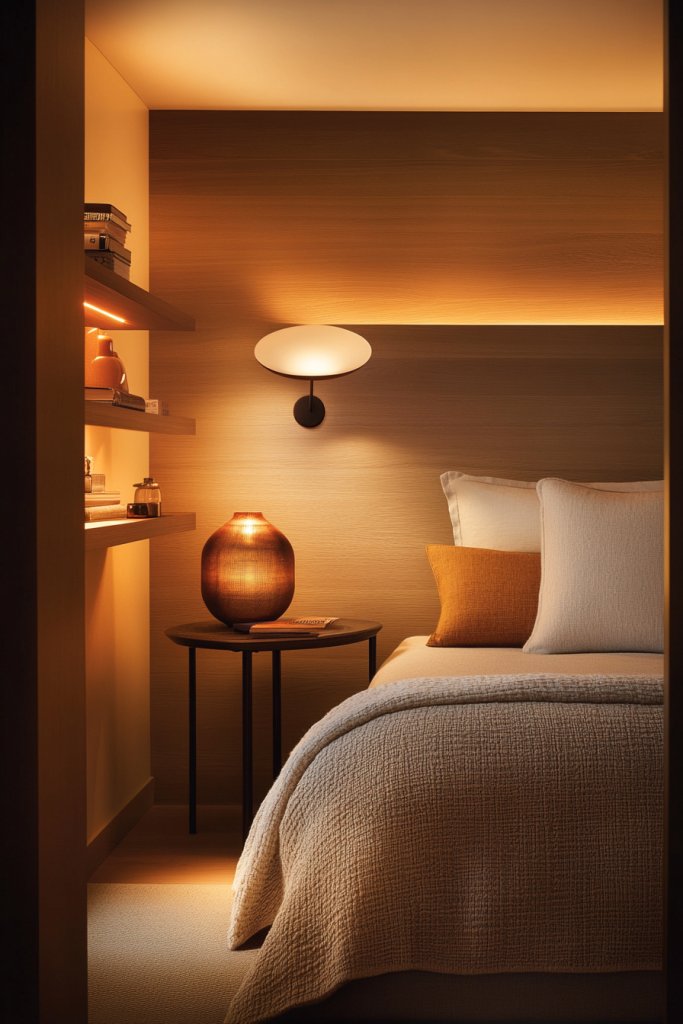
Good lighting in a small room can dramatically change its perception, making it feel larger, more inviting, and full of personality. Layering different types of light—ambient, task, and accent—creates a cozy ambiance, adds visual depth, and highlights your decor choices.
This multifaceted approach ensures your space is functional and beautiful at any time of day. Picture a room illuminated by a soft, overhead semi-flush ceiling fixture emitting warm, diffuse light.
Complement this with wall-mounted sconces on either side of the room, casting gentle pools of light that add depth and eliminate harsh shadows. On a side table, a table lamp with a textured ceramic base provides task lighting, perfect for reading or working.
To add a finishing touch, install LED strip lights along shelves or behind furniture to create a subtle glow that enhances the room’s layers and textures. To implement layered lighting, start with a warm-toned ceiling fixture that covers the main area.
Add wall sconces or swing-arm lamps for task lighting, choosing options with adjustable brightness. Incorporate LED strip lights or battery-operated puck lights under shelves or behind furniture for accent lighting. Use dimmable bulbs or smart switches to adjust the atmosphere easily, creating a warm, inviting space that feels larger and more dynamic.
8. Stylish Area Rugs to Define Zones and Add Visual Interest

In small rooms, an area rug isn’t just a decorative element—it’s a tool that visually divides the space into functional zones and adds texture and color. A well-chosen rug anchors your furniture arrangement, introduces pattern, and enhances the overall aesthetic without overwhelming the room.
Imagine a soft, plush geometric-patterned rug in shades of blush and cream laid out beneath a compact bed and seating nook. Its textured surface invites barefoot comfort and creates a cozy atmosphere.
The rug’s bold pattern contrasts with smooth wooden flooring, adding visual interest and helping to define the sleeping or sitting area. The tactile quality of the fibers also absorbs sound, making the room feel quieter and more intimate.
To incorporate a stylish rug, measure your space carefully to avoid overwhelming it. Opt for size options like 5×7 or 4×6 feet that suit your furniture layout.
Choose materials like wool, cotton, or synthetic fibers based on your budget and maintenance preferences. Place the rug so that it extends slightly beyond your furniture edges, creating a cohesive zone. Layering with smaller mats or runners can add further dimension, making your small room feel more expansive and inviting.
9. Floating Shelves for Decorative Items and Essential Storage
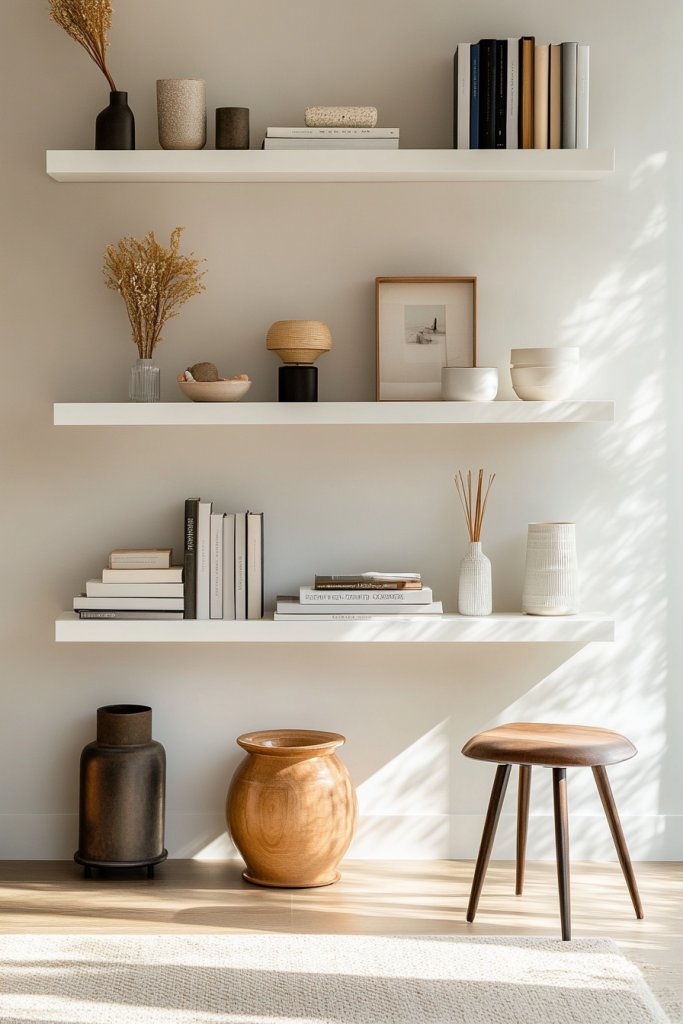
Floating shelves are a sleek, versatile way to add both storage and decorative flair to a small room. They free up floor space while giving you a platform to display cherished objects or keep everyday essentials close at hand, blending function with style effortlessly.
Visualize a set of minimalist white floating shelves arranged vertically on a wall, holding a collection of ceramic vases, small books, and metallic sculptures. The open design keeps the room feeling airy, while the varied heights and arrangement create visual movement.
The shelves are illuminated subtly by nearby lighting, highlighting their contents and adding warmth. This setup turns blank wall space into a curated gallery, elevating the entire room’s aesthetic.
To install floating shelves, measure and mark positions where you want them to sit, ensuring they are level and securely anchored into studs or wall anchors for safety. Use wood or engineered wood for a clean look, or opt for metal brackets if you prefer a more industrial vibe.
Keep the decorations simple—think small potted succulents, candles, or framed photos—to prevent clutter. With minimal effort, floating shelves transform your small room into a stylish, organized space that feels larger and more personalized.
10. Minimalist Decor with Clean Lines for a Calm, Open Feel
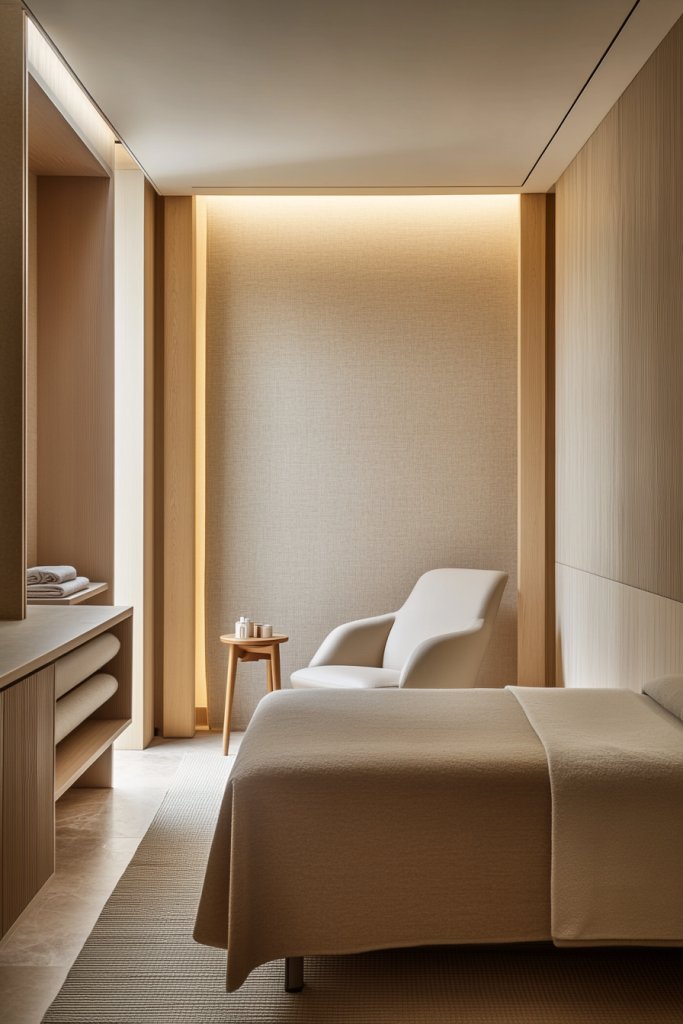
Creating a serene and spacious atmosphere in a small room often starts with minimalist decor characterized by clean lines and simple forms. This approach prioritizes decluttering and emphasizes open space, making the room feel larger and more peaceful.
Think sleek furniture with smooth surfaces, unadorned walls, and a restrained color palette that avoids overwhelming the senses. Visually, this style features a neutral base—soft whites, warm beiges, or muted grays—paired with subtle textures like a plush, low-pile rug or a smooth linen throw.
Furniture pieces are streamlined, such as a low-profile sofa with straight arms or a rectangular coffee table with slender legs. The space feels airy, with plenty of negative space allowing your eye to rest, and natural light floods in through unadorned windows, enhancing the calm vibe.
Decorative details are minimal, often limited to a single, thoughtfully chosen accessory like a ceramic vase or a simple framed print, which adds personality without clutter. To achieve this look, start by selecting furniture with clean, unembellished lines—think a platform bed with a plain headboard or a floating shelf.
Keep surfaces clear and avoid excess decor; instead, opt for a few high-quality, functional pieces. Use soft textiles like a light linen curtain or a tactile throw blanket in neutral tones.
Incorporate a few well-placed decorative objects, such as a sleek ceramic bowl or a simple geometric sculpture, to add interest without cluttering the space. Keep the color palette restrained, and focus on maintaining an uncluttered environment for a truly calming retreat.
11. Using Transparent or Light-Colored Furniture to Enhance Openness
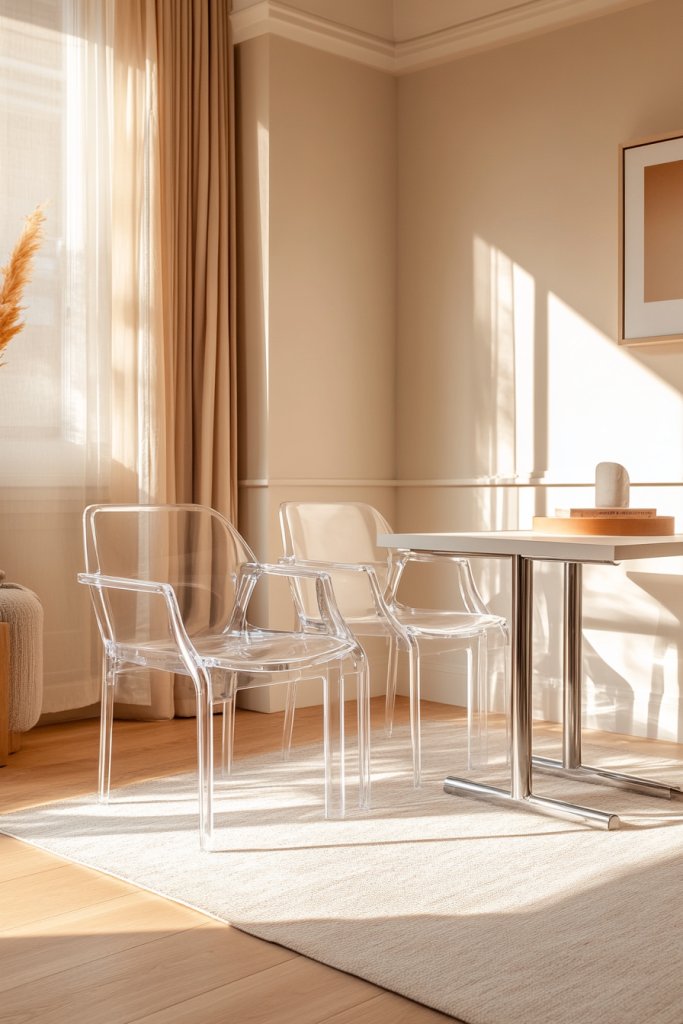
In small rooms, furniture can either shrink or expand the perceived space. Transparent or light-colored pieces are a smart choice because they visually recede, allowing light to pass through and making the room feel more open and airy.
Think acrylic chairs, glass tables, or pale wooden storage units that blend seamlessly into the background, creating an unobstructed sense of space. Visualize a room where a clear acrylic chair sits beside a soft, pastel-colored sofa, and a glass-top coffee table reflects natural light streaming through the window.
Light-colored furniture—such as a whitewashed wooden bed frame or a cream-colored dresser—brightens the space, while transparent pieces add a modern, almost invisible presence that doesn’t weigh the room down. These elements also contribute to a cohesive, uncluttered aesthetic, especially when paired with soft textiles and minimal decor.
The overall effect is a space that feels expansive, fresh, and inviting, with every element contributing to an open feel. To bring this concept to life, choose furniture with light hues—think white, cream, or pale wood—or opt for clear acrylic or glass surfaces.
For example, a transparent side table or a lucite chair can be combined with soft, textured cushions in pastel tones. Pair these with simple, sleek storage solutions that don’t visually block the space, like open shelving or light-colored cabinets.
When arranging, keep the furniture spaced out enough to avoid overcrowding, and maximize natural light to enhance the airy vibe. This approach transforms your small room into a bright, open haven that feels larger than it actually is.
12. Incorporating Textile Accents: Throws, Cushions, and Curtains for Color and Texture
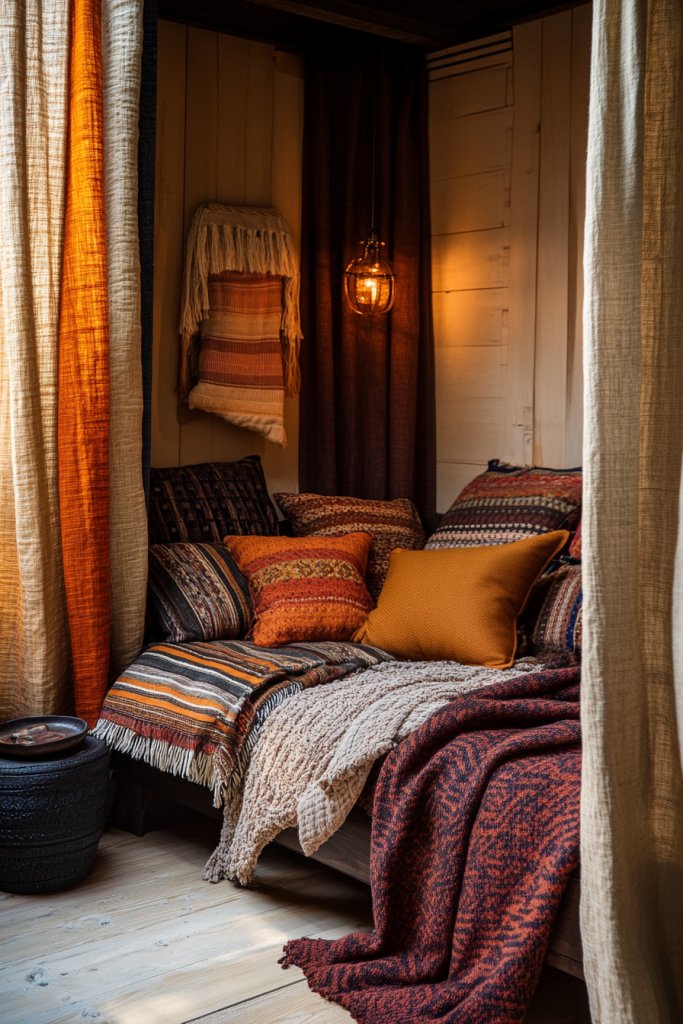
Textiles are your secret weapon for adding warmth, personality, and depth to a small room without overwhelming the space. Incorporating throws, cushions, and curtains in various textures and colors can transform a neutral environment into a cozy, inviting retreat.
These accents also help define zones and add visual interest, making the space more dynamic and layered. Imagine a soft, cream-colored throw with chunky knit texture draped over a sleek linen sofa, paired with cushions in deep jewel tones and plush velvet.
Light, airy curtains in a subtle pattern frame the windows, softening the natural light and creating a gentle, calming ambiance. Combining different textures—smooth silk, rough linen, cozy knits—adds tactile richness that invites touch and comfort.
These textile accents also introduce color and pattern in a controlled way, allowing you to personalize the space without cluttering it. To implement this idea, select a few key textiles such as a cozy throw blanket, decorative cushions, and curtains that complement your existing color palette.
Mix textures for visual interest, like a velvet cushion with a woven throw or a cotton curtain with a subtle pattern. Choose fabrics that are easy to clean and maintain, and consider seasonal swaps—lighter fabrics for summer, plush textures for winter. These accents can be layered effortlessly, providing warmth and personality while keeping the room feeling fresh and welcoming.
13. Clever Use of Door and Wall Hooks for Extra Storage and Decor
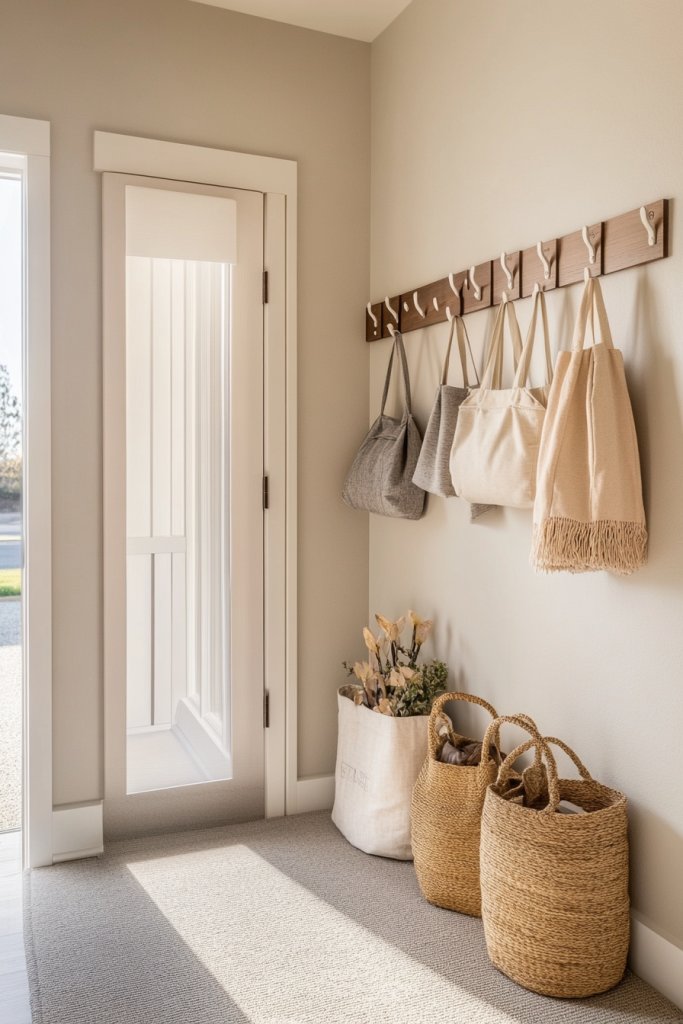
Maximizing small room space often means thinking vertically—door and wall hooks are perfect tools for adding storage without sacrificing floor space. They are versatile, easy to install, and can serve both functional and decorative purposes.
From hanging keys and bags to displaying decorative items, hooks help keep clutter out of sight while adding a personalized touch. Visualize hooks installed on a door or wall, holding everything from chic tote bags to lightweight scarves, or even a set of decorative baskets hanging from sturdy hooks for additional storage.
Stylish hooks in matte black, brass, or painted wood can add a subtle decorative element that complements your room’s aesthetic. For an extra design touch, consider grouping hooks in geometric patterns or arranging them in a vertical line to maximize visual impact.
These simple additions keep essentials within reach and free up drawer or shelf space, making your room feel more organized and spacious. To make the most of this idea, choose durable hooks suitable for the weight of your items—metal or heavy-duty plastic are reliable options.
Install hooks at different heights to create an organized display, and use adhesive hooks if you want a damage-free solution. Incorporate decorative elements like a stylish key hanger or a set of hooks with unique shapes for visual interest. With just a few hooks, you can turn an otherwise unused wall or door into a clever storage zone that keeps your small space tidy and visually appealing.
14. Layered Window Treatments to Control Light and Add Style
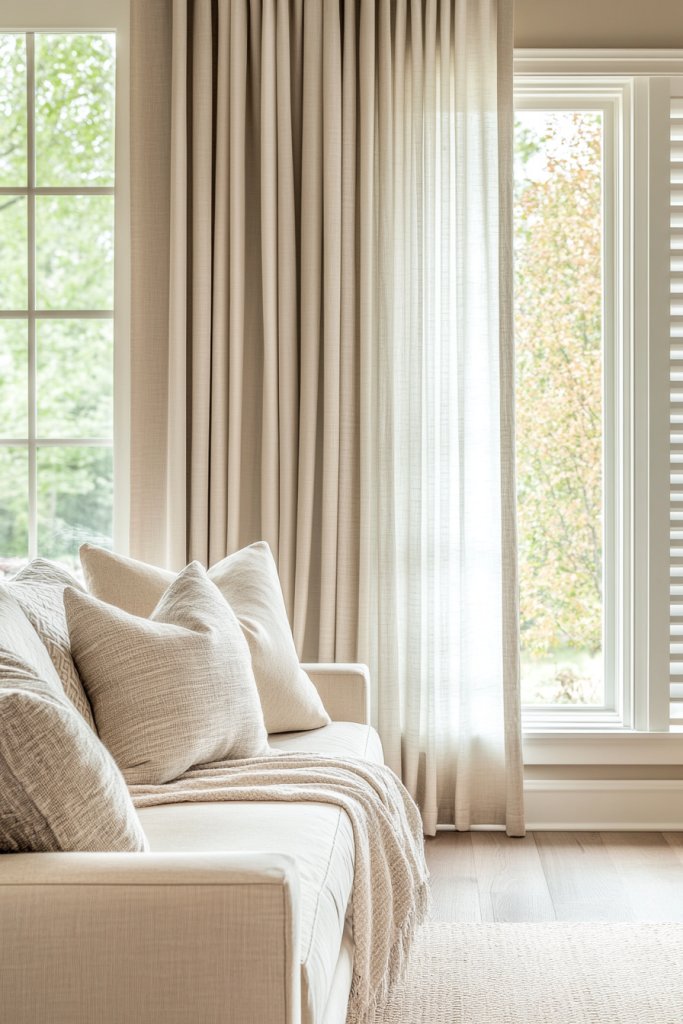
Layered window treatments are a game-changer for small rooms, offering both practical light control and a chance to add depth and texture to your space. They help you achieve a cozy, polished look while allowing flexibility in managing sunlight and privacy.
This approach creates a layered visual effect that makes the windows a stylish focal point rather than just a functional element. Imagine a set of sheer, white curtains paired with heavier, textured drapes in a soft neutral tone.
The sheer curtains diffuse natural light, creating a gentle glow that makes the room feel larger and airier, while the thicker curtains can be drawn for complete privacy or to block out light during movie nights. Adding a sleek roller shade or bamboo blinds underneath offers even more control, giving you options for adjusting the ambiance throughout the day.
The combination of fabrics and textures—like linen, velvet, or cotton—adds visual interest and tactile softness, making the space feel inviting and layered. The overall effect is a balanced, stylish window that enhances the room’s personality.
To implement layered window treatments, start with a simple, lightweight curtain rod that can support multiple layers. Hang sheer curtains first, ensuring they’re wide enough to pool slightly on the sides for a luxurious look.
Next, add your heavier drapes or blinds, choosing materials that complement your room’s color palette—think soft beige, blush pink, or muted gray. For a budget-friendly upgrade, consider using fabric panels from home decor stores or repurposing old curtains.
Use tiebacks or holdbacks to easily switch between different lighting and privacy settings. With a little DIY effort, you’ll create a versatile window setup that elevates your small space effortlessly.
15. Utilizing Color Blocking and Accent Walls to Add Visual Depth
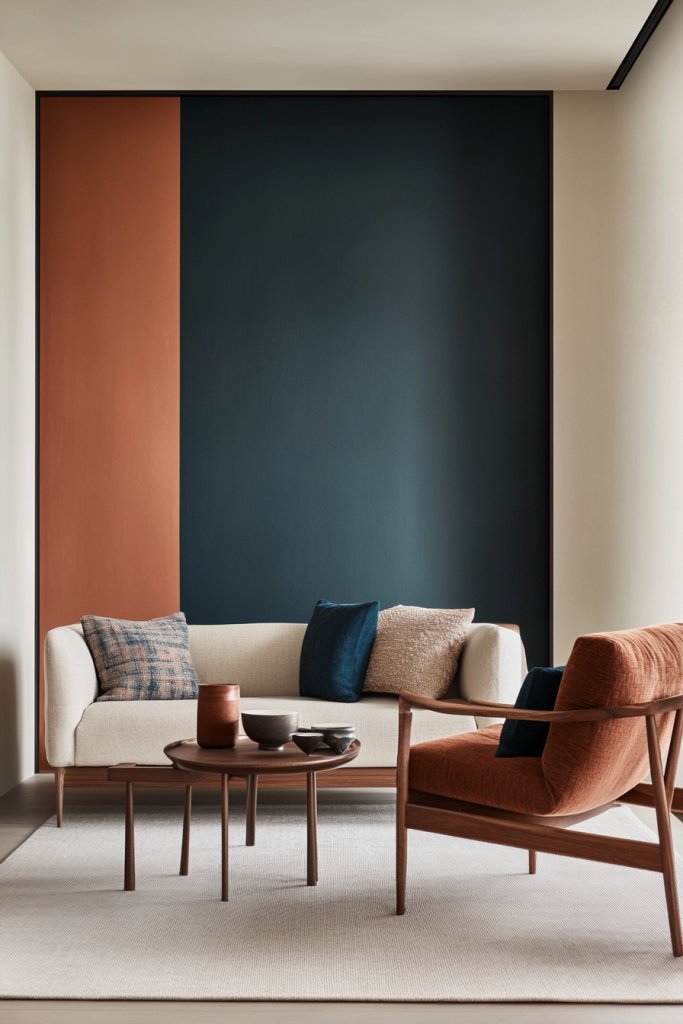
Color blocking and accent walls are strategic design tools that can instantly transform a small room into a dynamic, visually interesting space. They create an illusion of depth and dimension, making the room appear larger and more lively.
This technique is especially effective in small spaces because it draws the eye and adds a sense of structure without clutter or overcrowding. Picture a soft, neutral backdrop—like a pale gray or warm beige—serving as the main color, with a bold, contrasting accent wall in a rich navy, deep emerald, or muted terracotta.
The accent wall becomes a focal point, giving the room a sense of layered depth. Alternatively, you could use color blocking with geometric shapes, such as a large, off-center rectangle in a pastel hue on one wall, balanced with crisp white or charcoal lines.
This creates a modern, playful vibe that adds energy without overwhelming the space. Incorporating matte or satin finishes can enhance the visual interest and keep the look sophisticated and cohesive.
To bring this idea to life, choose two or three complementary colors that suit your style and mood. Use painter’s tape to create clean, straight lines for geometric blocks, or opt for a large, single-color statement wall.
For a softer, more blended look, incorporate different shades of the same color family—like light blush and darker rose tones. Be sure to prep your walls with a smooth primer and apply high-quality paint for a flawless finish. This simple yet impactful technique makes your small room feel more expansive and personalized.
16. Incorporating Unique Decorative Objects for Personal Style
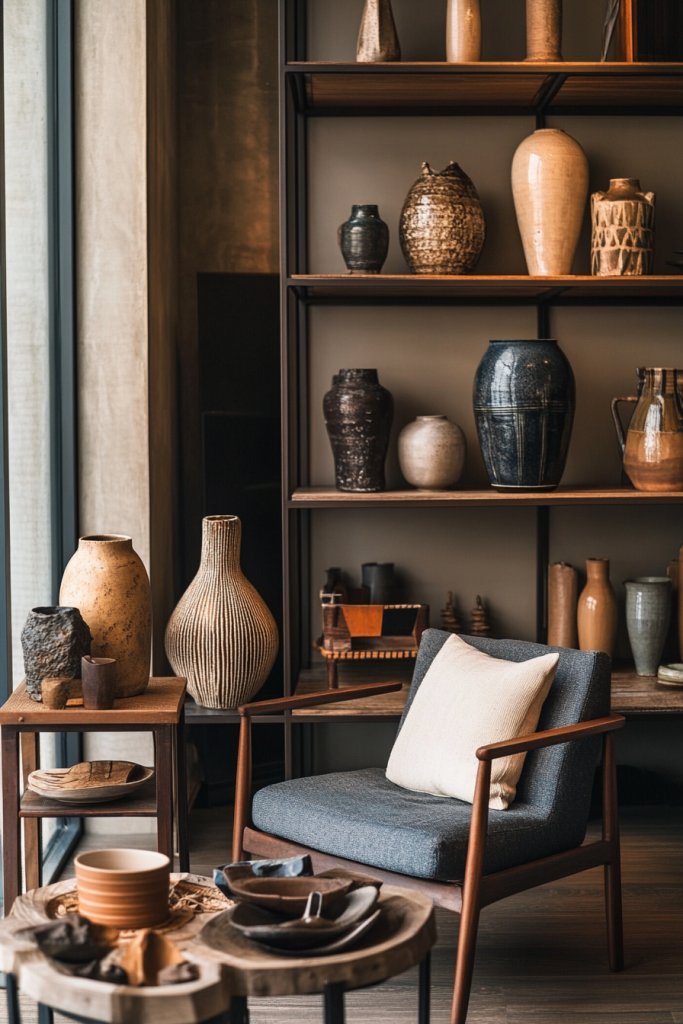
Adding distinctive decorative objects to a small room instantly infuses it with personality and charm. These items serve as visual anchors and conversation starters while also breaking up minimalistic or monotonous spaces.
Carefully chosen objects can reflect your interests, hobbies, or cultural influences, transforming a simple space into a curated, inviting retreat. Imagine a collection of handcrafted ceramic vases in earthy tones, a vintage sculpture, or a set of quirky, colorful candles arranged on a floating shelf.
These objects can be placed on side tables, open shelving, or atop a console to add layers of visual interest. Incorporate textured items like woven baskets, glass cloches with decorative trinkets, or curated stacks of books with meaningful covers.
Mixing materials—such as matte ceramics, shiny metals, and matte woods—creates a rich, tactile experience that energizes the room. Small-scale objects, like decorative bowls or unique figurines, can be grouped for impact without cluttering.
To incorporate these objects successfully, start by identifying what resonates with your style—be it modern, bohemian, vintage, or eclectic. Shop at thrift stores, craft markets, or online boutiques for one-of-a-kind finds that suit your aesthetic and budget.
Display them thoughtfully on open shelves, in glass jars, or on top of furniture to keep the space feeling curated rather than cluttered. Remember, less is more; select a few statement pieces and rotate them periodically to keep your space fresh and reflective of your evolving style.
17. Tips for Arranging Small Rooms to Maximize Functionality and Flow
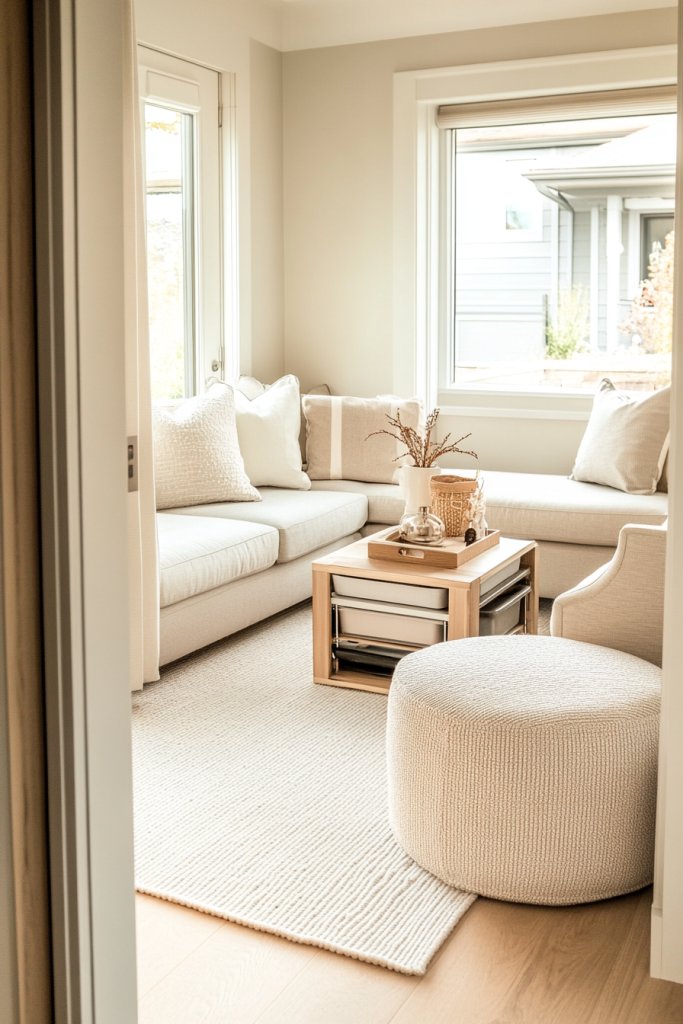
Arranging a small room effectively is essential to maximize both its functionality and visual flow. Thoughtful placement of furniture and accessories can make the space feel open, organized, and inviting, rather than cramped or chaotic.
The goal is to create a balanced layout that promotes easy movement and highlights your room’s best features. Start by identifying your main activities—whether it’s sleeping, working, relaxing, or entertaining—and prioritize furniture placement accordingly.
Use multi-purpose pieces like a fold-out sofa bed, a storage ottoman, or a wall-mounted desk to save space. Position larger furniture against the walls to open up the central area, ensuring enough clearance for doorways and walkways.
Keep clutter to a minimum by using smart storage solutions such as under-bed drawers, wall-mounted hooks, or floating shelves, which maximize vertical space. Incorporate symmetry and consistent spacing to create a harmonious flow, and use rugs or lighting to define different zones within the room.
For a practical setup, sketch out your layout on paper or use online room planner tools. Start with the largest pieces, like the bed or desk, and arrange them to avoid blocking windows or natural light sources.
Use furniture with slim profiles or transparent materials—like acrylic chairs or glass tables—to maintain a sense of openness. Keep frequently used items within reach and avoid overcrowding surfaces. With strategic placement and clever storage, your small room can become an efficient, stylish haven that feels larger and more comfortable every day.
Conclusion
With a wealth of creative solutions—from multi-functional furniture and clever storage hacks to bright color palettes and personalized decor—there’s no limit to transforming small spaces into inspiring, functional retreats. By trying out these ideas, you can maximize every inch and create a room that feels larger, brighter, and uniquely yours.
Embrace the challenge and let your small room become a bold statement of style and ingenuity. Start transforming your space today and turn tiny rooms into extraordinary places!
Leave a Reply